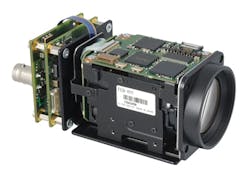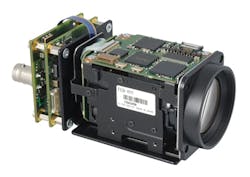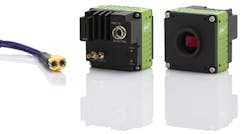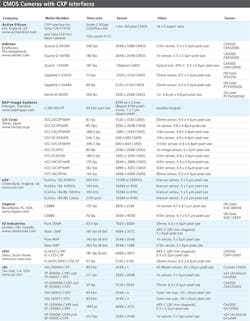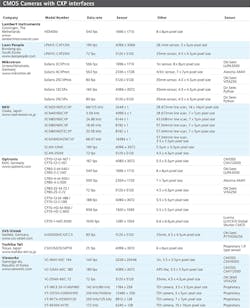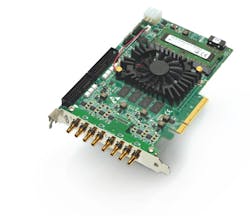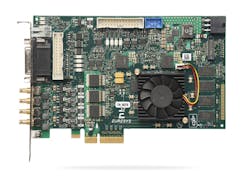It has been seven years since the CoaXPress (CXP) standard was introduced at VISION 2009 in Stuttgart. Since then, the standard has become somewhat a de-facto camera-to-computer interface for high-performance camera systems since, after usurping the well-established Camera Link standard, CXP allows vendors to increase the data throughput of their CMOS-based camera systems.
To date, numerous camera and frame grabbers have endorsed the interface with a range of CMOS and CCD cameras, frame grabbers, cables and connectors (see "CoaXPress cameras and frame grabbers tackle high-speed imaging," Vision Systems Design, January 2014).
CXP Specifications
As an asymmetric point-to-point serial communication standard, the CXP-6 version features a high speed downlink of up to 6.25Gbps per cable and a 20Mbps uplink for communications and control. Just as Camera Link supported a Power over Camera Link mode, so too does CXP Power (Power over Coax) while also offering the systems developer camera-to-computer coax cable connection lengths of up to 100m.
While a single CXP-6 high-speed link delivers speeds of 6.25Gbps, the standard offers a number of different bit rates ranging from CXP-1 (1.25Gbps) to CXP-6 (6.25Gbps) with maximum camera-to-computer distances from 212m (CXP-1) to 68m (CXP-6). These data rates and cable distances have been tabulated at http://bit.ly/2e7rMe7.
In the design of its VCC- VCXP3M and VCC-VCXP3R VGA cameras, for example, CIS Corp (Tokyo, Japan, www.ciscorp.co.jp) offers a number of selectable frame rates that include 269 fps (CXP-1), 538 fps (CXP2) and 536.7 fps (CXP3). To increase this data rate further, multiple links can be used. Indeed, today, a number of manufacturers have introduced both cameras and frame grabbers that use four CXP-6 links providing data rates of 25Gbps.
Aggregating several links can achieve double or quadruple the data rate of 12.5Gps or 25Gbps, respectively. Here, the number of links used depends on the maximum output speed of the sensor and/or the data rate. In the design of its CXP interface for Sony block cameras, for example, Active Silicon (Iver, England; www.activesilicon.com) has used a single 2.5Gbps CXP-2 link to support all the HD modes of the camera - 1080i and 720p at 50Hz or 60Hz-of the 1/3in 2M pixel CMOS imager used in the camera (Figure 1).
Multiple links
Where faster megapixel imagers are used, manufacturers must opt to provide multiple CXP-6 links. When such sensors are used, cameras can be configured around different CXP configurations to provide the speed and bit depth required. For example, JAI (San Jose, CA, USA; www.jai.com) uses the Lince5M 2560 x 2048 CMOS sensor from Anafocus (Seville, Spain; www.anafocus.com) - now part of e2V (Chelmsford, England, UK; www.e2v.com) - in its Lince5M-based cameras.
Studying the datasheet of the Lince5M at http://bit.ly/2dDkZax reveals that the 2560 x 2048 1 in. CMOS imager can be operated in 12-bit mode at a maximum rate of 250 fps. At such frame rates and bit depths, four CXP-6 links are required by JAI's SP-5000M-CXP4 (monochrome) and SP-5000C-CXP4 (color) cameras. However, the sensor can also be operated at less than its full data rate when interface bandwidth is limited.
For example, the Lince5M can output full resolution at a reduced 211 fps, 8 bit mode using two CXP-6 links, a fact that has been realized in the design of JAI's SP-5000M-CXP2 and SP-5000C-CXP2 CXP cameras (Figure 2). A number of benefits result including fewer drivers and equalizers to implement the CXP interface and allowing deployment of dual-camera configurations using four-link CXP frame grabbers available from Active Silicon, BitFlow (Woburn, MA, USA; www.bitflow.com), Euresys (Angleur, Belgium; www.euresys.com) and others.
Four CXP-6 links are also used to support the data rates from image sensors such as the AM41 from Alexima (Pasadena, CA, USA; www.alexima.com). While Mikrotron (Unterschleissheim, Germany; www.mikrotron.de) uses the device in its EoSens 4CXPm/c Optronis (Kehl, Germany; www.optronis.com) uses the AM41 in its CP80-4-M/C-500 camera (see "CMOS Cameras with CXP Interfaces" table on page 18 of this issue).
Interestingly, the specifications of these cameras found on the Mikrotron and Optronis websites differs very slightly from the original AM41V4 data sheet specification that can be found at http://bit.ly/2ebbzVz. Regardless, using four CXP links allows both cameras to transfer 4Mpixel images at data rates of approximately 500 fps at full resolution.
More than four
While many currently available frame grabbers support such four-link cameras, Kaya Instruments (Haifa, Israel; www.kayainstruments.com) Komodo CXP frame grabber is capable of receiving image data from up to eight CoaXPress links in single, dual, quad or octal modes (Figure 3). Thus, it can be used to simultaneous capture image data from two quad CXP-6 link cameras at a maximum data rate of 25Gbps per camera allowing dual camera systems with a maximum data rate of 50Gbps on a single frame grabber.
Interestingly, at the time of writing, Vieworks (Gyeonggi-do, Republic of Korea; www.vieworks.com) 12MPixel 8-connection CoaXPress camera, the VC-12MX2-M330, announced at last month's VISION Stuttgart trade show, was shown coupled to two Euresys Coaxlink Quad G3 frame grabbers running at 330 fps. Also showcased were eight new TDI camera models featuring proprietary, hybrid TDI (Time Delayed Integration) sensors that combine CCD-based pixel array with a light sensitive and noiseless charge transfer and accumulation process, with fast CMOS readout electronics. The resulting high sensitivity and high dynamic range sensor is said to offer CCD-like image quality, with the speed and low power consumption commonly found in CMOS sensors.
However, such designs have not been widely adopted for reasons that may include the cost of adding additional drivers and equalizers in the cameras and the additional cost of the cables required to implement single camera/frame grabber octal CXP-6 systems. There is not a reason why this could not be accomplished, however, since cameras that use devices such as the CMV12000 from CMOSIS (Antwerp, Belgium; www.cmosis.com) could benefit from such implementations.
Indeed, the specification of the CMOSIS 12MPixel 4096 x 3072 device running at 300 fps in 10-bit mode would necessitate a data rate of approximately 38Gbps and eight CXP-6 links. This necessitates camera developers such as IO Industries (London, ON, Canada; www.ioindustries.com) that use the CMV12000 in its Flare 12M180-CX, a four-channel CXP-6 implementation, to run the device at a slower data rate of 187 fps.
Going faster
It is unlikely that many camera and (perhaps) other frame grabber vendors will adopt octal CXP-6 based implementations, but rather wait for the next generation of higher-speed drivers and equalizers. This will increase the current maximum data rate from the existing 6.25Gbps (CXP-6) by adding 10Gbps (CXP-10) and 12.5Gbps (CXP-12.5). Of the number of camera manufacturers contacted for this article, many were still awaiting to receive samples of higher speed drivers and equalizers.
"All of our cameras are designed around current 6.25Gbps CXP-6 standard due to the unavailability of the new CXP driver chip," says Yusuke Muraoka, President of CIS Corp, "but we will definitely look into the faster standard once the standard and the devices are ready." Similarly, Mikrotron did not show a CXP-10 or CXP-12.5 camera at the VISION Show last month.
"CXP-12 is on the company's roadmap and will find its way into Mikrotron CXP cameras but not until mid to late next year," says Steve Ferrell, Head of Business Development at Mikrotron's North American Office (Poway, CA, USA). "I understand that Microchip Technology (Chandler, AZ, USA; www.microchip.com) is not scheduled to go into production with parts until Q3 2017," he added.
While many camera vendors appear to be either lacking sample ICs to increase the speed of their CXP-based cameras, it seems that frame grabber vendors have already received engineering samples. Marc Damhaut, Chief Executive Officer of Euresys notes the company is currently working on prototypes and proofs of concept for these two new versions of the standard (Figure 4).
"We have built a prototype of CXP-10 frame grabber using engineering samples of the forthcoming Microchip Technology devices," he says. The company chose last month's VISION 2016 show in Stuttgart to display the frame grabber in cooperation with Microchip and Adimec (Eindhoven, The Netherlands; www.adimec.com). "We're also working on validating a CXP-12 interface based on Macom (Lowell, MA, USA; www.macom.com) devices."
Active Silicon is also developing a frame grabber to support CXP-10 and CXP-12.5, according to Colin Pearce, CEO. Although this was also announced at VISION 2016, the company did not exhibit the board.
Speed benefits
Developers of high frame rate cameras use devices such as CMOSIS' CMV12000 to achieve full device frame rates of 38Gbps using quad CXP-12.5 links and single quad-link frame grabbers. Line-scan camera manufacturers may benefit from reducing the number of CXP cables required and increase camera throughput with the emerging CXP-10 and CXP-12.5 standards.
At present, for example, the XCM16K04GT4CXP, 16384 x 1 line-scan camera from NED (Osaka, Japan; www.ned-sensor.co.jp) uses four CXP-5 connectors to output data at 68.97kHz. This number of connectors could be reduced should the company choose to implement the emerging CXP standards. While the speed and resolution of both line-scan and area-scan CMOS imagers will continue to increase to meet the demands of applications such as industrial inspection and medical imaging, so too will the high-speed interfaces needed to support them.
Formerly, relatively small companies led such CMOS device innovations. Lately, however, there has been rapid consolidation in the marketplace with companies such as Anafocus, CMOSIS and Truesense Imaging (Rochester, NY, USA) being acquired by e2V, the AMS Group (Premstaetten, Austria; http://ams.com) and ON Semiconductor (Phoenix, AZ, USA; www.onsemi.com), respectively.
Whether this somewhat stifles the innovation of novel CMOS imagers remains to be seen. Camera companies wishing to more effectively differentiate their products, however, will need to seek newer sensor start-ups or invest in custom CMOS imagers.
Companies mentioned
Active Silicon
Iver, England
www.activesilicon.com
Adimec
Eindhoven, The Netherlands
www.adimec.com
Alexima
Pasadena, CA, USA
www.alexima.com
The AMS Group
Premstaetten, Austria
http://ams.com
Anafocus
Seville, Spain
www.anafocus.com
Awaiba
Funchal, Madeira, Portugal
www.awaiba.com
BAP Image Systems
Erlangen, Germany
www.bapimgsys.com
BitFlow
Woburn, MA, USA
www.bitflow.com
CIS Corp
Tokyo, Japan
www.ciscorp.co.jp
CMOSIS
Antwerp, Belgium
www.cmosis.com
e2V
Chelmsford, England
www.e2v.com
Euresys
Angleur, Belgium
www.euresys.com
Imperx
Boca Raton, FL, USA
www.imperx.com
IO Industries
London, Ontario, Canada
www.ioindustries.com
ISVI
Seoul, S. Korea
www.isvi-corp.com
JAI
San Jose, CA, USA
www.jai.com
Kaya Instruments
Haifa, Israel
www.kayainstruments.com
Lambert Instruments
Groningen, The Netherlands
www.lambertinstruments.com
Laon People
Bundang-gu, South Korea
www.laonpeople.com
Luxima Technology
Pasadena, CA, USA
www.luxima.com
MACOM
Lowell, MA, USA
www.macom.com
Microchip Technology
Chandler, AZ, USA
www.microchip.com
Mikrotron
Unterschleissheim, Germany
www.mikrotron.de
NED
Osaka, Japan
www.ned-sensor.co.jp
ON Semiconductor
Phoenix, AZ, USA
www.onsemi.com
Optronis
Kehl, Germany
www.optronis.com
SVS-Vistek
Seefeld, Germany
www.svs-vistek.com
Toshiba Teli
Tokyo, Japan
www.toshiba-teli.co.jp
Vieworks
Gyeonggi-do, Republic of Korea
www.vieworks.com
For more information about CoaXPress products, visit Vision Systems Design's Buyer's Guide buyersguide.vision-systems.com
About the Author

Andy Wilson
Founding Editor
Founding editor of Vision Systems Design. Industry authority and author of thousands of technical articles on image processing, machine vision, and computer science.
B.Sc., Warwick University
Tel: 603-891-9115
Fax: 603-891-9297
